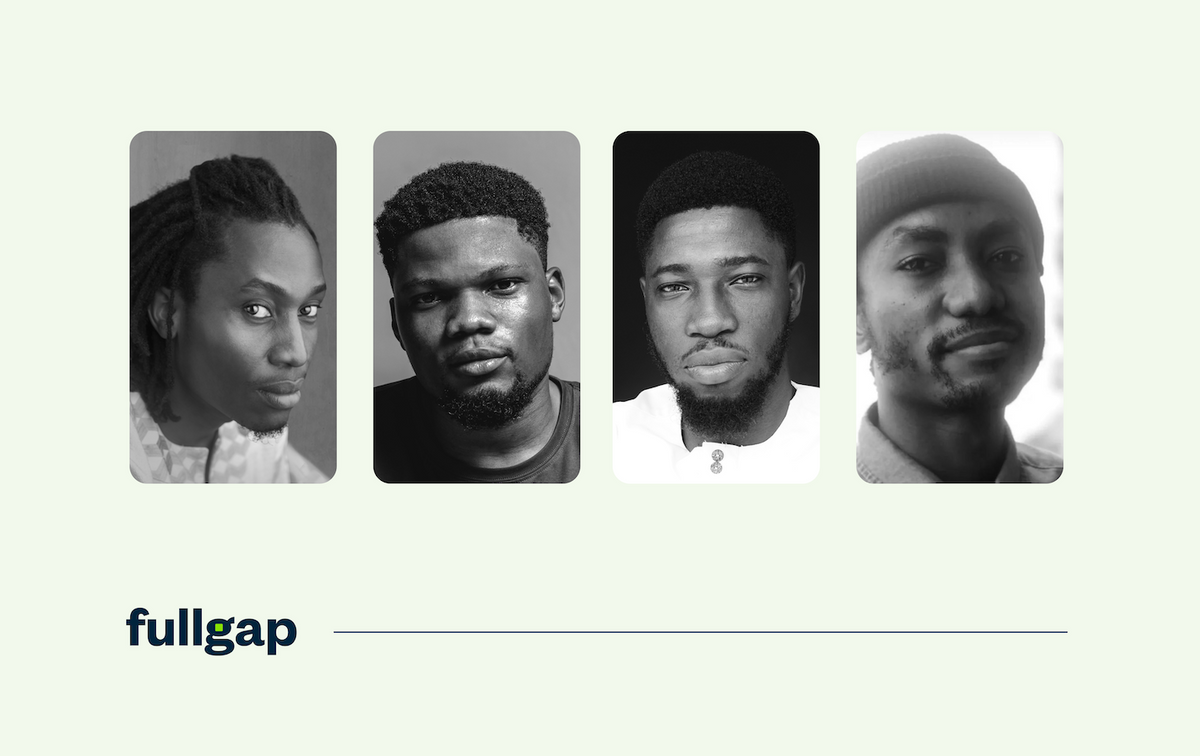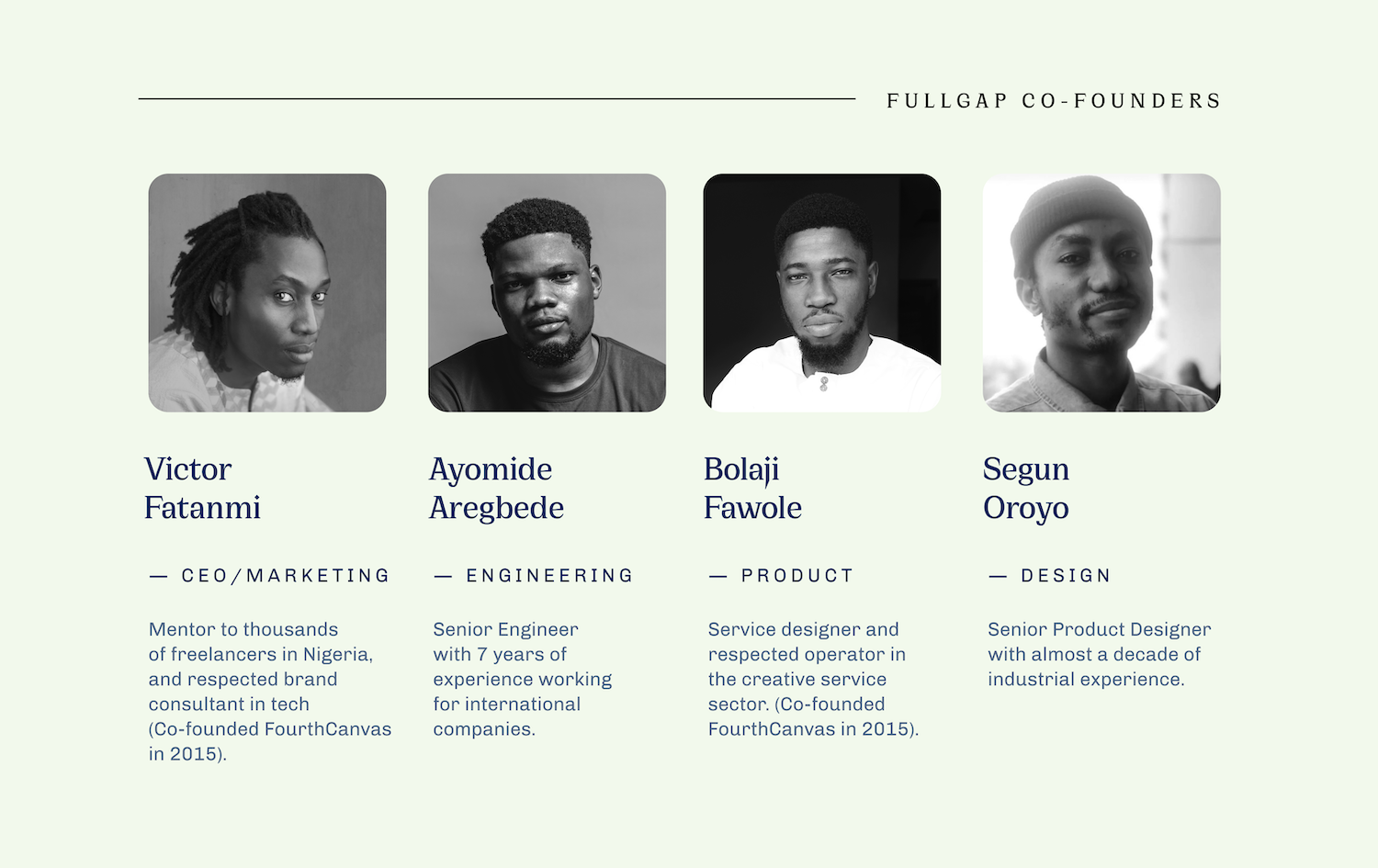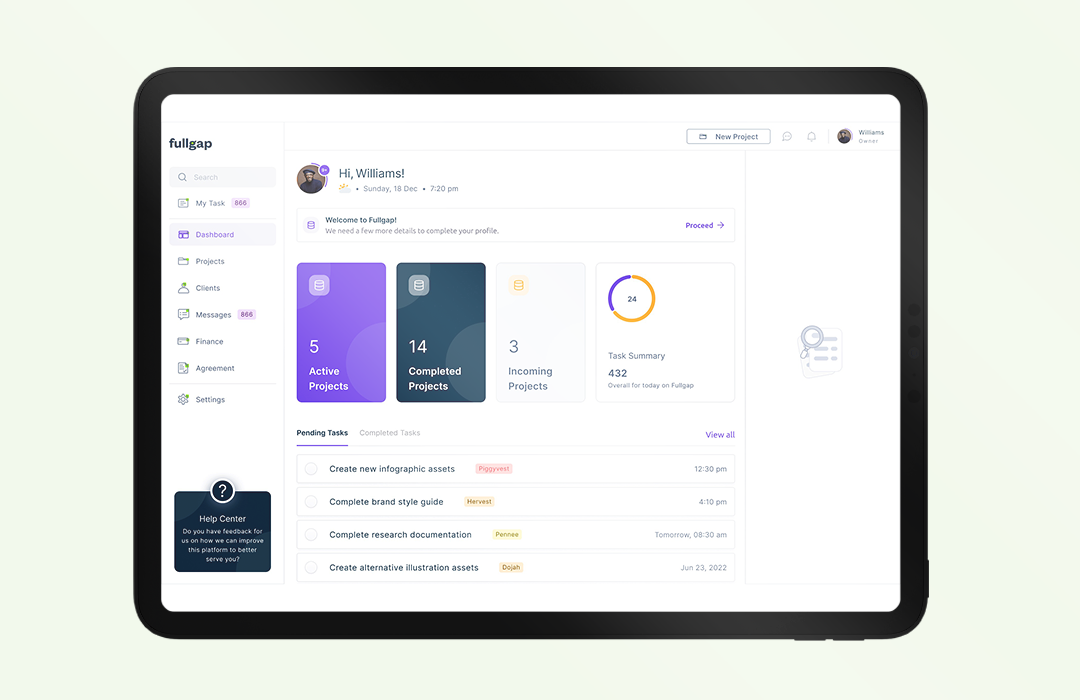How Fullgap is tapping into the new world of work with Africa’s HoneyBook
Fullgap is building the operating system for freelancers. In just three weeks of the public beta launch, they acquired their first 3,000 users. Here is my interview with two of the co-founders.

In the beginning was FUTA, where the co-founders met
In 2011, Victor Fatanmi—Fullgap’s CEO and co-founder—was a student of Estate Management at the Federal University of Technology, Akure (FUTA) in Ondo State. The course of study, Estate Management, was not Victor’s first choice. “I originally wanted to study Architecture. This is because as a kid, I was artistic. But Architecture seemed to have a lot of maths, which I didn’t like. So, I randomly opted for the next closely-related course in the faculty—Estate Management. I didn’t know Graphic Design existed as a thing,” he tells me.
Expectedly, it didn’t take him too long to become disinterested in Estate Management and disillusioned with school in general. “Finding out that Design was an actual profession lit a bulb in my head. So, I started to practise it on my own, and opportunities began to show up—to the extent that I became a truant who was always in Lagos for work,” says Victor. Simultaneously, he was freelancing as a designer on campus. Becoming the Student Union Director of Sports in 2013 helped him grow in popularity, positively affecting his one-man design business. But soon, it became overwhelming.
Enter Bolaji Fawole—co-founder of Fullgap and soldier-wannabe who was Victor’s roommate. “Thanks to the movies I watched as a kid, I wanted to become a Soldier,” says Bolaji. “All I had to do was figure out what role I would play in the military.” And if there is anything to note about soldiers, it’s their discipline. So, I was not surprised to hear that Bolaji played an unofficial COO role in helping Victor to stabilise his design business on campus.
Eventually, they turned the design “side hustle” into an agency on campus. In 2014, they recruited Segun Oroyo, a student who already sustained himself with the proceeds from his freelance jobs as a designer, to help lay the foundation for the agency's web and digital design operations. In 2015, that agency rebranded to become FourthCanvas, with Segun staying on as a founding team member.
Ahead of the 2015 elections in Nigeria, the team worked with Ayomide Aregbede, a budding software engineer on campus, to build a digital platform that educated the electorates about the contestants. “It failed, but it was an exciting first attempt to build a digital product,” says CEO Victor.
In 2017, Segun went on to lead product design at a software company, while Ayomide continued to grow as a software engineer and consultant for local and international clients. The design agency has since grown in popularity and scope (to include brand strategy), working with leading African brands like Piggyvest and Nomba.
See also: Nomba, a pan-African fintech, raises $30m Series B round
The four co-founders share four things in common. First, they all enrolled at FUTA. Second, each of them dropped out—at different times. Third, they all continued to grow in their chosen paths. Finally, they all share a passion for disrupting the status quo and being world-class.
So, when it was time to build Fullgap, Victor and Bolaji tapped their former colleagues who were now seniors in their fields.

But why Fullgap?
“Scaling Bolaji”—structure meets creativity with Fullgap
“Meeting Bolaji helped me, as a creative person, to become more structured and professional. By ‘scaling Bolaji’, I believe we can help other creators to scale their craft,” says Victor. Simply because not everyone can recreate the fate of meeting ‘a Bolaji’ but everyone can create a Fullgap account”.
Fullgap started because Bolaji, the Director of Operations at FourthCanvas since 2015, was looking for how to manage the scaling of their operations from one client and a few projects to multiple clients and projects. “If you are not great at managing the complexity that comes with growth as an agency, it could break your company”, he tells me.
The existing solutions for managing the complexity Bolaji described were not accessible to Africans on the continent, had a bad user experience, felt sub-optimal or all of the above. “HoneyBook (a 10-year-old US-based client flow management software) had created something good in the right direction, but it still didn’t fully solve our problem. If they did, there'd probably not be a Fullgap today,” says Bolaji in a jokingly-serious tone.
Fullgap was formed to solve the project management-related complexities at FourthCanvas. However, the desire to build a product had already been brooding in the minds of the CEO and COO. To them, it was a way of “taking their own pills”. “We always advise clients on what to do with their products and brands. So, now we want to take our advice,” Victor says. ”At first, we had thought about building a portal for companies to manage their brand guidelines—moving away from the ineffective PDF guidelines. But my cofounder had another idea, which has morphed into Fullgap.”
Initially, Victor was not aboard the idea of building Fullgap because he already set his eyes on that product for digital brand guidelines. But Bolaji, a ruthless executor, had already started piecing together an early prototype of a client flow management software to convince his business partner that this was better. And it did just that. The MVP—built largely with interns at FourthCanvas, with the guidance of one of FourthCanvas’ partners, Aremu Oluwagbamila, provided a first view of what was possible. But then, more dedication was required to build the envisioned quality of the product Bolaji had in mind. “The initial MVP didn’t live up to the expectation of a better product experience than what I’d seen in the market, so we took it down to start all over,” says Bolaji.
Starting all over is where the experienced professionals, Segun and Ayomide, come in with their expertise in product design and software engineering, respectively. It was a restart, and together the four co-founders set out to deploy more resources and fashion out their next steps, which involved incorporating the new company, articulating the vision and mission, and hiring a cross-functional team across design, engineering, product management and brand-building.
“Fullgap is the future of getting work done”, says the CEO

After speaking to the duo for a long time, I finally asked them to define what Fullgap is, and Victor said, “It’s an operating system for freelancers or anyone getting work done.” The company views its primary customers as freelancers, “many of whom we had hired, trained, or managed through the agency for nearly a decade”. They believe that freelancing is the future of work, “Thanks to COVID-19, massive layoffs and ChatGPT as a tool to strengthen 1-person enterprises, there are all the markings on the wall of a freelance-first future”. Hence, they add the line “or anyone getting work done” to their pitch.
The co-founders of Fullgap have seen first-hand how much they achieved when they combined their talent with adequate systems, processes and structures. They believe the product could have a generational impact as more young people (with Gen Zs making up a large chunk) across Africa can create more value for themselves, their clients, and the economy. Fullgap wants to be that system that helps them deliver efficiently and scale the business side of their work. “Segun always says that he needs to build a user experience that adds no extra layer of complexity. So that people can focus on the things that matter, like doing the job itself,” says Victor.
I am a part of the early beta users of Fullgap, and three of my favourite features are the ability to create projects, generate simple agreements and create task line items that help me track my deliverables on a project. “We don’t think it is only about people getting better at organising their work. We think the act of organising in itself needs to get simpler,” he adds. “That premise has informed our simplification, not aggregation, of many existing productivity tools. Early feedback from our first 3,000 users confirms that Fullgap may be the future of getting work done and delivered.”
I moved an ongoing project with a client to @FullgapCo and all I can say is that @FullgapCo is making the freelancers lifestyle easier...
— Ayomidotun (@ayomidxtun) May 8, 2023
Thanks to the team#PowertotheCreativeOnes pic.twitter.com/ylVaUKO3Fb
Three thousand users in three weeks (April 21) of the public beta launch, acquired without paid advertising, is no mean feat. And that springs up another conversation about how they’ve approached marketing—which could be a story on its own. Their tagline, “Power to the creative ones”, inscribed on tote bags, has flooded my Twitter timeline. “We cut through the noise with our message ‘Power to the creative ones’. And although it might sound like a stretch, our marketing approach has been compared to that of Phil Knight’s Nike (‘Just do it’). Unlike most tech products, we’ve started with a brand bigger than the product in people's minds. What we are doing now is the iterative effort to live it out regarding product experience quality.”
"Power to the creative ones ✊" really slaps hard, too hard to be indifferent!
— Michael Adeyemi 🚀 (@filabrands) March 24, 2023
Already sounds more like a movement to me.#fullgap
However, like most tech products, they also go the venture-backed route. First, they raised a friends and family round of over $100,000 from the likes of Victor Asemota, Kola Oyeneyin and Olumide Soyombo. But “we will be raising soon,” adds Victor, CEO of Fullgap.
Key links referenced in the article:
- Public user feedback on Fullgap
- Fullgap's pitch deck
- LinkedIn profile of the founders–Victor, Bolaji, Segun, and Ayomide
- Fullgap's website






